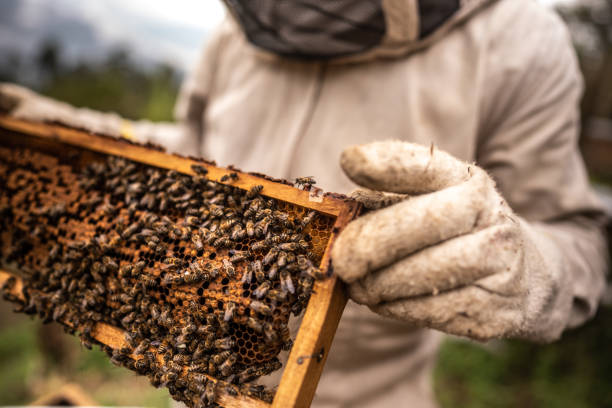What to Do When You Find a Beehive on Your Property
Discovering a beehive on your property can be alarming, especially if it’s near your home or in a high-traffic area. If you're dealing with an unexpected hive, bee removal is the safest and most effective solution to protect your family and property. Knowing what steps to take—and which to avoid—can make all the difference in handling the situation calmly and responsibly.
Why Bees Choose Your Property
Bees are drawn to areas that provide shelter and access to food. Common locations for hives include:
- Hollow trees
- Attics
- Wall cavities
- Sheds and garages
- Under decks or eaves
The presence of flowers, fruit trees, or water sources increases the likelihood of bees setting up a hive nearby. Understanding why bees have chosen your property can help prevent future infestations.
Step 1: Stay Calm and Observe from a Distance
The first thing you should do is stay calm. Bees are not naturally aggressive unless they feel threatened. Approach with caution and observe the hive from a safe distance. Avoid sudden movements or loud noises that could provoke the colony.
Step 2: Don’t Attempt to Remove It Yourself
Many homeowners make the mistake of trying to remove the hive on their own. DIY methods like using water, fire, sprays, or smoke often lead to dangerous situations. Bees will defend their hive fiercely, and stings can cause allergic reactions or hospitalization in severe cases.
Additionally, some DIY methods harm the environment and can lead to the death of bees, which are vital pollinators. Improper removal can also leave behind honeycomb, attracting other pests like ants or rodents.
Step 3: Identify the Type of Bees
Before calling in help, it’s useful to identify what kind of bees you're dealing with. Honeybees, bumblebees, and carpenter bees all behave differently, and so do wasps or hornets, which are often mistaken for bees. Honeybees, for instance, are protected in many regions and should be relocated rather than exterminated.
You can take photos (from a distance) and share them with a local expert or pest control company for identification.
Step 4: Contact a Professional Bee Removal Service
This is the most critical step. A professional bee removal service has the knowledge, tools, and safety gear to handle the hive correctly. They can safely remove or relocate the colony while minimizing harm to the bees and avoiding structural damage to your property.
Professionals will also:
- Seal entry points to prevent re-infestation
- Remove leftover hive material
- Ensure there’s no damage to your home
Hiring a licensed and insured company ensures you’re covered in case of any accidents during the process.
Step 5: Prevent Future Hives
Once the hive is removed, it’s important to take steps to prevent bees from returning:
- Repair holes or gaps in siding and roofing
- Use screens on vents and chimneys
- Keep garbage bins sealed
- Remove fallen fruit and sugary items from the yard
- Limit strong floral scents and open containers of food outdoors
You might also consider planting bee-repelling herbs like eucalyptus, citronella, or peppermint around your home.
Environmental Responsibility
While you may be concerned about your safety, it’s also essential to consider the wellbeing of the bees. Bees are crucial pollinators, and their populations are under threat due to pesticides, habitat loss, and disease.
Look for bee removal professionals who prioritize humane relocation. Many companies work with beekeepers who will take the hive to a new home where it can thrive and continue pollinating.
Common Myths About Bee Removal
Myth 1: Smoke always works to drive bees away.
While smoke can calm bees temporarily, it doesn’t remove the hive. It’s not a permanent solution and may actually aggravate the situation if done incorrectly.
Myth 2: Killing the bees solves the problem.
Even if the bees are exterminated, the hive and honey left behind can create new problems, including attracting pests or mold.
Myth 3: Bee removal is too expensive.
Many professional services are affordable and may be covered under homeowners insurance, especially if the hive poses a threat.
When It’s an Emergency
Sometimes, immediate removal is necessary, such as:
- Bees nesting inside the walls of your home
- Aggressive bees attacking people or pets
- Allergic household members at risk of severe reactions
- Hives blocking pathways or high-traffic areas
In these cases, don’t wait—contact an emergency bee removal specialist right away.
The Legal Side of Bee Removal
In some areas, especially where honeybees are protected, it's illegal to destroy a hive without proper authorization. Licensed removers understand local laws and will follow all necessary regulations.
Check with your local municipality if you’re unsure about the rules in your area.
Choosing the Right Bee Removal Expert
When hiring a bee removal company, consider the following:
- Licensing & Insurance: Always verify credentials.
- Experience: Choose a company that specializes in bees, not just general pest control.
- Reviews: Look at online feedback and ask for references.
- Methods Used: Opt for humane, environmentally friendly options.
- Pricing: Get an estimate up front, and confirm if follow-up services are included.
You can also search terms like “bee removal near me” to find highly rated local providers.
Final Thoughts
Finding a beehive on your property can be unsettling, but handling the situation properly ensures safety for your family—and the bees. Avoid DIY methods, identify the type of bee, and call in a professional for safe and humane bee removal. By taking swift and informed action, you can resolve the issue efficiently while doing your part to protect our environment.





Comments